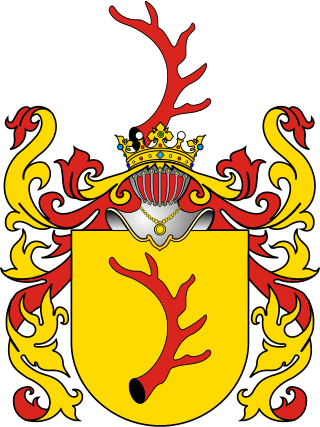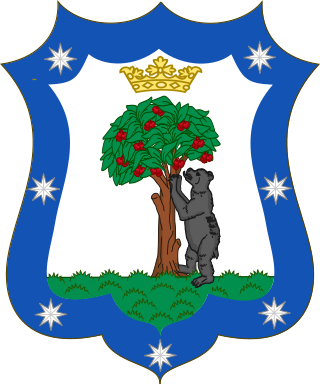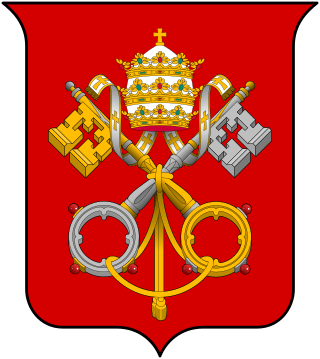Papal heraldry may refer to:
Papal heraldry may refer to:

Heraldry is a discipline relating to the design, display and study of armorial bearings, as well as related disciplines, such as vexillology, together with the study of ceremony, rank and pedigree. Armory, the best-known branch of heraldry, concerns the design and transmission of the heraldic achievement. The achievement, or armorial bearings usually includes a coat of arms on a shield, helmet and crest, together with any accompanying devices, such as supporters, badges, heraldic banners and mottoes.

A coat of arms is a heraldic visual design on an escutcheon, surcoat, or tabard. The coat of arms on an escutcheon forms the central element of the full heraldic achievement, which in its whole consists of a shield, supporters, a crest, and a motto. A coat of arms is traditionally unique to the armiger. The term "coat of arms" itself, describing in modern times just the heraldic design, originates from the description of the entire medieval chainmail "surcoat" garment used in combat or preparation for the latter.

A motto is a sentence or phrase expressing a belief or purpose, or the general motivation or intention of an individual, family, social group, or organisation. Mottos are usually found predominantly in written form, and may stem from long traditions of social foundations, or from significant events, such as a civil war or a revolution. One's motto may be in any language, but Latin has been widely used, especially in the Western world.

In heraldry, supporters, sometimes referred to as attendants, are figures or objects usually placed on either side of the shield and depicted holding it up.

A galero is a broad-brimmed hat with tasselated strings which was worn by clergy in the Catholic Church. Over the centuries, the red galero was restricted to use by individual cardinals while such other colors as black, green and violet were reserved to clergy of other ranks and styles.

Papal regalia and insignia are the official items of attire and decoration proper to the Pope in his capacity as the visible head of the Catholic Church and sovereign of the Vatican City State.

The umbraculum is a historic piece of the papal regalia and insignia, once used on a daily basis to provide shade for the pope. Also known as the pavilion, in modern usage the umbraculum is a symbol of the Catholic Church and the authority of the pope over it. It is found in the contemporary Church at all the basilicas throughout the world, placed prominently at the right of their main altars. Whenever the pope visits a basilica, its umbraculum is opened.
Papal coats of arms are the personal coat of arms of popes of the Catholic Church. These have been a tradition since the Late Middle Ages, and has displayed his own, initially that of his family, and thus not unique to himself alone, but in some cases composed by him with symbols referring to his past or his aspirations. This personal coat of arms coexists with that of the Holy See.

The personal papal coat of arms of Pope Benedict XVI was designed by Archbishop Andrea Cordero Lanza di Montezemolo soon after the papal election in 2005.

The law of heraldic arms, sometimes simply laws of heraldry governs the possession, use or display of arms, called bearing of arms. That use includes the coats of arms, coat armour or armorial bearings. Originally with the sole function of enabling knights to identify each other on the battlefield, they soon acquired wider, more decorative uses. Today they are used by countries, public and private institutions or individuals. The first laws regarding arms were written by Bartolus de Saxoferrato and the officials who administer these matters today are called pursuivants, heralds, or kings of arms. The law of arms is part of the law in countries which regulate heraldry, although not part of common law in England and in countries whose laws derive from English law. In most European countries without monarchies, much like in the United States, there are no laws against assuming arms, with the closest legal authenticity mechanism being a pictorial copyright protection.

Bruno Bernard Heim was a Swiss prelate and Latin Titular Archbishop of Xanthus, a long-serving diplomat of the Holy See who among other appointments was Apostolic Delegate to Great Britain, and later Apostolic Pro-Nuncio, and eventually Apostolic Nuncio, serving until his retirement as a diplomat in 1985.

The tradition and art of heraldry first appeared in Spain at about the beginning of the eleventh century AD and its origin was similar to other European countries: the need for knights and nobles to distinguish themselves from one another on the battlefield, in jousts and in tournaments. Knights wore armor from head to toe and were often in leadership positions, so it was essential to be able to identify them on the battlefield.

The lion is a common charge in heraldry. It traditionally symbolises courage, nobility, royalty, strength, stateliness and valour, because historically the lion has been regarded as the "king of beasts". The lion also carries Judeo-Christian symbolism. The Lion of Judah stands in the coat of arms of Jerusalem. Similar-looking lions can be found elsewhere, such as in the coat of arms of the Swedish royal House of Bjelbo, from there in turn derived into the coat of arms of Finland, formerly belonging to Sweden.

Ecclesiastical heraldry refers to the use of heraldry within Christianity for dioceses, organisations and Christian clergy. Initially used to mark documents, ecclesiastical heraldry evolved as a system for identifying people and dioceses. It is most formalized within the Catholic Church, where most bishops, including the Pope, have a personal coat of arms. Clergy in Anglican, Lutheran, Eastern Catholic and Eastern Orthodox churches follow similar customs, as do institutions such as schools and dioceses.

A crown is often an emblem of a sovereign state, usually a monarchy, but also used by some republics.

In heraldry and heraldic vexillology, a blazon is a formal description of a coat of arms, flag or similar emblem, from which the reader can reconstruct the appropriate image. The verb to blazon means to create such a description. The visual depiction of a coat of arms or flag has traditionally had considerable latitude in design, but a verbal blazon specifies the essentially distinctive elements. A coat of arms or flag is therefore primarily defined not by a picture but rather by the wording of its blazon. Blazon is also the specialized language in which a blazon is written, and, as a verb, the act of writing such a description. Blazonry is the art, craft or practice of creating a blazon. The language employed in blazonry has its own vocabulary, grammar and syntax, which becomes essential for comprehension when blazoning a complex coat of arms.

Biberstein is a Polish coat of arms. It was used by several szlachta families in the times of the Kingdom of Poland and the Polish–Lithuanian Commonwealth.

The bear as heraldic charge is not as widely used as the lion, boar or other beasts.

The coat of arms of the Holy See combines two crossed keys and a tiara, used as a coat of arms by the Holy See. These forms have origins attested from the 14th century. The combination of one gold and one silver key is a somewhat later development.
Vatican heraldry refers to the heraldry in the Vatican City State. These include the coat of arms of Vatican City and the papal coats of arms. The heraldry of the Vatican also rules the arms and heraldic insignia of Roman Catholic priests, dioceses and abbeys around the world.